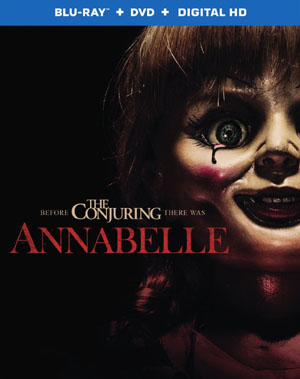 ANNABELLE
ANNABELLE
(R)
MOVIE: ***1/2 (out of 5)
BLU-RAY EXPERIENCE: **1/2 (out of 5)
STARRING
Annabelle Wallis as MIA
Ward Horton as JOHN
Tony Amendola as FATHER PEREZ
Alfre Woodard as EVELYN
Studio: Warner Bros.
Directed by: John R. Leonetti
BY KEVIN CARR
While I never considered myself a huge fan of James Wan’s films (I felt the original “Saw” was cool, but some of his follow-ups like “Dead Silence” was pretty bad), I respect the hell out of him for pioneering a new look for modern horror that steers as far clear from the dreadful found footage quagmire as can be. With both “Insidious” and “The Conjuring,” Wan brought back the 70s-era slow-burn horror movie, finding its scares in practical effects amid light and shadow as well as long, steady shots that are supported by both silence and intense music cues.
While Wan did not direct “Annabelle” (which is a prequel spin-off of “The Conjuring”), his fingerprints are all over it, and that helps the movie along.
Telling the story of the demonic Annabelle doll introduced in the opening of “The Conjuring,” “Annabelle” follows a young married couple who are ready to give birth to their first child. One night, a home invasion next door spills into their house. The invaders – two people from a demonic cult trying to conjure an inhuman demon – are killed, but they leave their mark on the family’s porcelain doll. Soon, new mother Mia (Annabelle Wallis) starts to experience unexpected and sometimes violent events at home. She begins to consider that she and her baby might be the target for the demon possessing the doll.
“Annabelle” is not nearly as good as “The Conjuring” was, and it doesn’t have the depth of character and story that its predecessor does. However, that doesn’t stop it from being an effective movie. In fact, “Annabelle” feels more like a sequel to Wan’s “Insidious” than to “The Conjuring” because it deals with some very similar ideas (e.g., a demon trying to steal a child and the haunting following a family from one home to the next).
The film came out this previous October, and it played well into the nature of the month of Halloween. Like “The Conjuring,” the period setting of “Annabelle” lends itself to the classic horror movie filmmaking moments.
Of course, the film isn’t perfect, and at times it does rely too much on the “baby in danger” set-up (see the discussion of deleted scenes later for more on this). However, for those who don’t remember what it was like to be around during this time period, “Annabelle” captures the hopelessness of the 60s/70s-era trapped housewife. It seems so archaic now with society’s diversified attitude on men raising children and women working and scheduling time outside of the home.
Sure, “The Babadook” is far more effective in mining the psychological horrors of dealing with motherhood. However, as a man who raised (and is still raising) three boys as a stay-at-home dad, I can say that I can definitely connect with the occasional isolation felt in a situation like this.
Not perfect, but still a fun, creepy ride, “Annabelle” works and is worthy of its sister production like “The Conjuring” and the “Insidious” films.
The Blu-ray combo pack comes with the Blu-ray and DVD with Digital Copy. The special features includes about 20 minutes of deleted scenes, which are better than most selections of what’s left on the cutting room floor. That doesn’t mean these scenes should have been left in the movie, as they amount mostly to additional creepy things that happen to Mia at home with the baby and the presence of a sleazy landlord of their apartment building. Aside from extra footage of the room carnage of the finale in which Mia faces off with the demon (which, in my opinion, could have added a bit to the film itself), these are all superfluous scenes. Still, they are finished and fully edited, so they’re interesting to watch.
The rest of the special features include four featurettes about the making of the movie. “The Curse of Annabelle” chronicles the inspiration from the Warrens and the real-life Annabelle doll (though it cleverly never shows the actual Annabelle doll, which is quite different from the one we know in the film). “Bloody Tears of Possession” examines the process of a single long take in the film’s first-act climax. “Dolls of the Demon” take a look at the other dolls in Annabelle’s posse. Finally, “A Demonic Process” shows how the crew developed the new demon’s look for this film.
